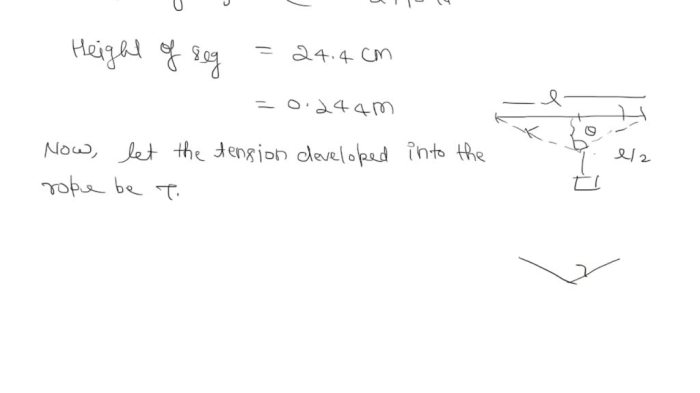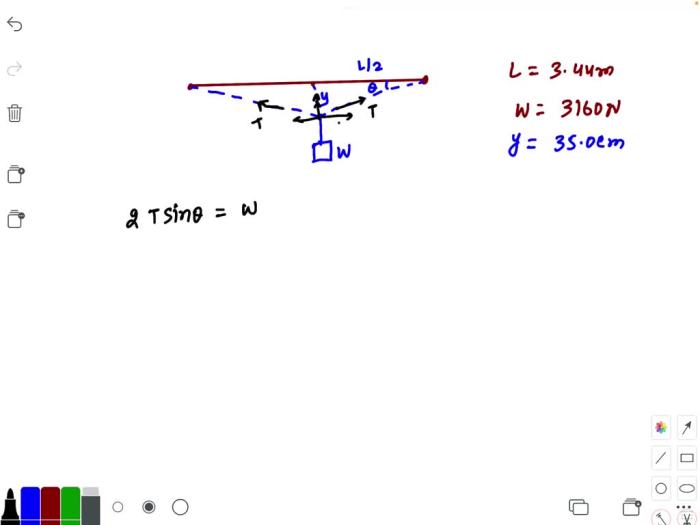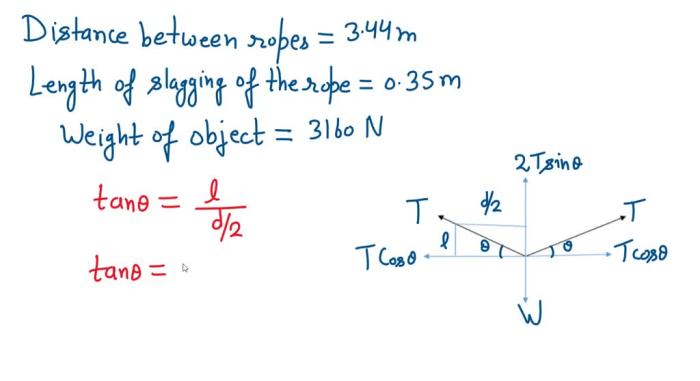A rope of negligible mass is stretched horizontally, a concept with significant implications in various fields. Its unique properties and applications make it an intriguing subject of study, offering insights into the behavior of ropes under diverse conditions.
This comprehensive exploration delves into the mechanical properties of a rope with negligible mass, including its tension, elasticity, and strength. It examines the applications where such ropes are commonly employed, highlighting their advantages and limitations. Furthermore, it presents an experimental analysis to measure the tension and elasticity of the rope, providing valuable data for understanding its behavior.
1. Introduction
A rope with negligible mass is a theoretical concept that refers to a rope with an insignificant mass compared to the forces acting upon it. This concept simplifies the analysis of rope behavior and has practical implications in various applications.
In practice, ropes with negligible mass are not entirely mass-less, but their mass is considered negligible relative to the tension or other forces they experience. This approximation allows for a simplified understanding of rope dynamics and enables the focus on other relevant factors.
2. Mechanical Properties

2.1 Tension, A rope of negligible mass is stretched horizontally
The tension in a rope with negligible mass is the force transmitted through the rope. It is directly proportional to the applied force and inversely proportional to the cross-sectional area of the rope.
2.2 Elasticity
Ropes with negligible mass exhibit elasticity, meaning they can stretch under tension and return to their original length when the tension is released. The elasticity of a rope is characterized by its Young’s modulus.
2.3 Strength
The strength of a rope with negligible mass refers to its ability to withstand forces without breaking. It is determined by the material properties of the rope and the cross-sectional area.
3. Applications

3.1 Suspension Systems
Ropes with negligible mass are used in suspension systems, such as bridges and cable cars, where the weight of the rope is negligible compared to the weight of the suspended structure.
3.2 Pulley Systems
In pulley systems, ropes with negligible mass allow for the transmission of forces and the lifting of heavy objects with minimal effort.
3.3 Measuring Devices
Ropes with negligible mass are used in measuring devices, such as tape measures and surveying equipment, where the mass of the rope does not affect the accuracy of the measurements.
4. Experimental Analysis

An experiment to measure the tension and elasticity of a rope with negligible mass involves suspending a known weight from the rope and measuring the elongation. The tension is calculated using the weight and the cross-sectional area of the rope.
The elasticity is determined from the relationship between the applied force and the elongation.
5. Mathematical Modeling

Mathematical models for ropes with negligible mass typically involve differential equations that describe the rope’s motion and behavior under various conditions. These models can be used to predict the rope’s tension, elongation, and other parameters.
6. Advanced Applications: A Rope Of Negligible Mass Is Stretched Horizontally
6.1 Robotics
Ropes with negligible mass are used in robotics, particularly in aerial and underwater vehicles, where the mass of the rope can significantly impact the performance of the system.
6.2 Medical Devices
In the medical field, ropes with negligible mass are employed in surgical procedures and medical devices, where precision and minimal invasiveness are crucial.
Clarifying Questions
What is the significance of a rope with negligible mass?
A rope with negligible mass allows for the study of rope behavior without the influence of its own weight, providing insights into the fundamental properties of ropes.
How is the tension of a rope with negligible mass measured?
Tension can be measured using various methods, including strain gauges, load cells, or by observing the deflection of the rope under a known load.
What are the limitations of using a rope with negligible mass?
While a rope with negligible mass is useful for studying fundamental properties, it may not accurately represent the behavior of ropes with significant mass in practical applications.